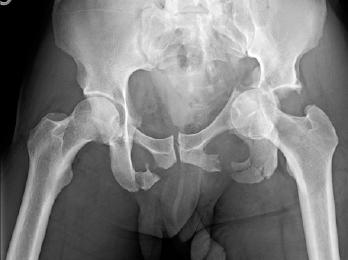
Explore This Issue
ACEP Now: Vol 40 – No 10 – October 2021Lateral compression pelvic ring injury and left-sided T-shaped acetabulum fracture.
Wiznia et al. Case Rep Orthop. 2016;2016:9706392. CC BY 4.0
The oldest Americans are the fastest-growing population in the United States.1 Older persons are more likely to experience trauma and to have worse outcomes after a trauma.2 Under-triaging may be the single most important modifiable factor associated with mortality and morbidity in our trauma systems. Observational studies suggest that when injured older patients are cared for at a regional trauma hospital, there is as much as a 25 percent reduction in mortality, a reduction in delirium, and fewer discharges to long-term care.3 In Ontario, where I work, more than two-thirds of older adults with major traumatic injuries (often related to minor mechanisms of injury such as ground-level falls) are triaged by EMS to a nontrauma center, and fewer than 50 percent of these patients are then transferred to a trauma center.4 This month, we’ll explore five myths about trauma and triage in older patients. Next month, we’ll bust myths about falls and other injuries common in this population
Myth 1: Transfer to a Trauma Center Is for Lifesaving Emergency Surgery Only
A pervasive myth is that patients need only be transferred to a regional trauma center if emergency surgery is likely to be required. Older patients with nonoperative injuries benefit from specialized trauma care from coordinated multidisciplinary teams at a regional trauma center.5 The lack of need for emergency surgery should not preclude consideration for transfer to a lead trauma center. I believe we should be advocates for our older trauma patients by ensuring that regional trauma transfer guidelines include frailty as a high-risk factor that should warrant the consideration of transfer at a lower threshold.
Myth 2: Prognostication of Trauma Patients Can Be Accurately Assessed Based on Age and Comorbidities in the ED
We have all cared for 90-year-old patients who seem to have the physiology of 70-year-olds and vice versa. While both age and frailty are somewhat predictive of poor outcomes after trauma, multiple studies using frailty scores have shown frailty to be more predictive of poor outcomes after trauma than age and even comorbidities.6–9 It has been suggested that the combination of a frailty index such as the Trauma-Specific Frailty Index and Geriatric Trauma Outcome Score may improve prediction of long-term outcomes, but this has yet to be studied.10,11 Prognostication scores following traumatic brain injury such as the International Mission for Prognosis and Analysis of Clinical Trials in TBI (IMPACT) Score have been validated in adults with a Glasgow Coma Scale score ≤12 and can predict six-month mortality when calculated in the first 24 hours of admission; however, this rarely applies to ED care.12
Pages: 1 2 3 4 | Single Page






No Responses to “Geriatric Trauma Myths and Misperceptions: Part 1”